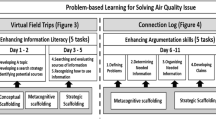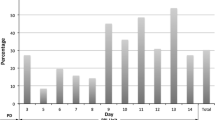Abstract
Scientific inscriptions—graphs, diagrams, and data—and argumentation are integral to learning and communicating science and are common elements in cyberlearning environments—those involving the use of networked learning technologies. However, previous research has indicated that learners struggle to use inscriptions and when they engage in argumentation, the learning of science content becomes secondary to the learning of argumentation skills. The purpose of this study was to evaluate two scaffolding strategies for these elements in a secondary school context: (1) self-explanation prompts paired with a scientific inscription and (2) faded worked examples for the evaluation and development of scientific arguments. Participants consisted of ninth and tenth grade students (age 13–16 years; N = 245) enrolled in state-mandated biology courses taught by four different teachers. A three-factor mixed model analysis of variance with two between factors (self-explanation prompts and faded worked examples) and one within factor (pre-, post-, delayed posttest) was used to evaluate the effects on the acquisition and retention of domain-specific content knowledge. Results indicated that neither strategy influenced the acquisition and retention of science content in a positive (i.e., learning) or negative (i.e., expertise reversal effect) way. Thus, general prompts were as effective as either of the scaffolding conditions. These unanticipated results suggest that additional research is warranted for learning scaffolds with pre-college populations where the gains were established with college-aged participants.




Similar content being viewed by others
References
Atkinson RK, Derry SJ, Renkl A, Wortham D (2000) Learning from examples: instructional principles from the worked examples research. Rev Educ Res 70(2):181–214
Atkinson RK, Renkl A, Merrill MM (2003) Transitioning from studying examples to solving problems: effects of self-explanation prompts and fading worked-out steps. J Educ Psychol 95(4):774–783. doi:10.1037/0022-0663.95.4.774
Barab S, Squire K (2004) Design-based research: putting a stake in the ground. J Learn Sci 13(1):1–14
Berthold K, Eysink THS, Renkl A (2009) Assisting self-explanation prompts are more effective than open prompts when learning with multiple representations. Instr Sci 37(4):345–363
Bowen G, Roth W (2002) Why students may not learn to interpret scientific inscriptions. Res Sci Educ 32(3):303–327
Bricker LA, Bell P (2008) Argumentation from science studies and the learning sciences and their implications for the practices of science education. Sci Educ 92(3):473–498
Chi MT, De Leeuw N, Chiu M, Lavancher C (1994) Eliciting self-explanations improves understanding. Cognit Sci 18(3):439–477. doi:10.1016/0364-0213(94)90016-7
Clark RE, Kirschner PA, Sweller J (2012) Putting students on the path to learning: the case for fully guided instruction. Am Educ 36(1):6–11
Crippen KJ, Earl BL (2007) The impact of Web-based worked examples and self-explanation on performance, problem solving, and self-efficacy. Comput Educ 49(3):809–821. doi:10.1016/j.compedu.2005.11.018
Cross D, Taasoobshirazi G, Hendricks S, Hickey DT (2008) Argumentation: a strategy for improving achievement and revealing scientific identities. Int J Sci Educ 30(6):837–861
Glazer N (2011) Challenges with graph interpretation: a review of the literature. Stud Sci Educ 47(2):183–210. doi:10.1080/03057267.2011.605307
Kalyuga S (2009) Instructional designs for the development of transferable knowledge and skills: a cognitive load perspective. Comput Hum Behav 25(2):332–338
Kalyuga S, Ayres P, Chandler P, Sweller J (2003) The expertise reversal effect. Educ Psychol 38(1):23–31
Keengwe J, Onchwari G, Wachira P (2008) Computer technology integration and student learning: barriers and promise. J Sci Educ Technol 17(6):560–565
Kern C, Crippen KJ (2013) A design framework and research program for enacting science cyberlearning. In: Bastiaens T, Marks G (eds) Proceedings of e-learn: world conference on e-learning in corporate, government, healthcare, and higher education 2013. Association for the Advancement of Computing in Education (AACE), Chesapeake, VA, pp 1195–1199
Kern C, Crippen KJ, Skaza H (2014) The fidelity and usability of 5-DIE: a design study of enacted cyberlearning. J Comput Math Sci Teach 33(1):513–536
Kim MC, Hannafin MJ (2011) Scaffolding problem solving in technology-enhanced learning environments (TELEs): bridging research and theory with practice. Comput Educ 56(2):403–417
Kirschner P, Sweller J, Clark RE (2006) Why unguided learning does not work: an analysis of the failure of discovery learning, problem-based learning, experiential learning and inquiry-based learning. Educ Psychol 41(2):75–86
Kissane M, Kalyuga S, Chandler P, Sweller J (2008) The consequences of fading instructional guidance on delayed performance: the case of financial services training. Educ Psychol 28(7):809–822
Lee H, Liu O (2010) Assessing learning progression of energy concepts across middle school grades: the knowledge integration perspective. Sci Educ 94(4):665–688
Martinez ME, Peters Burton EE (2013) Cognitive affordances of the cyberinfrastructure for science and math learning. Educ Media Int 48(1):17–26. doi:10.1080/09523987.2010.535333
Mayer RE, Hegarty M, Mayer S, Campbell J (2005) When static media promote active learning: annotated illustrations versus narrated animations in multimedia instruction. J Exp Psychol Appl 11(4):256–265
McKenney S, Reeves TC (2012) Conducting educational design research. Routledge, London
Notar CE, Zuelke DC, Wilson JD, Yunker BD (2004) The table of specifications: insuring accountability in teacher made tests. J Instr Psychol 31(2):115–129
Renkl A, Atkinson RK, Grobe CS (2004) How fading worked solution steps works: a cognitive load perspective. Instr Sci 32(1):59–82
Rew L, Becker H, Cookston J, Khosropour S, Martinez S (2003) Measuring cultural awareness in nursing students. J Nurs Educ 42(6):249–257
Roy M, Chi MT (2005) The self-explanation principle in multimedia learning. In: Mayer RE (ed) The Cambridge handbook of multimedia learning. Cambridge University Press, Cambridge, pp 271–286
Ruiz-Primo MA, Shavelson RJ, Hamilton L, Klein S (2002) On the evaluation of systemic science education reform: searching for instructional sensitivity. J Res Sci Teach 39(5):369–393
Schnotz W, Kürschner C (2007) A reconsideration of cognitive load theory. Educ Psychol Rev 19(4):469–508
Schwonke R, Renkl A, Krieg C, Wittwer J, Aleven V, Salden R (2009) The worked-example effect: not an artifact of lousy control conditions. Comput Hum Behav 25(2):258–266
Staker H, Horn MB (2012) Classifying k-12 blended learning. http://www.innosightinstitute.org/innosight/wp-content/uploads/2012/05/Classifying-K-12-blended-learning2.pdf
Sweller J (1988) Cognitive load during problem solving: effects on learning. Cogn Sci 12(2):257–285
Sweller J, Cooper GA (1985) The use of worked examples as a substitute for problem solving in learning algebra. Cogn Instr 2(1):59–89
van der Meij JJ, de Jong TT (2011) The effects of directive self-explanation prompts to support active processing of multiple representations in a simulation-based learning environment. J Comput Assist Learn 27(5):411–423
van Gog T, Paas F, van Merrienboer JG (2008) Effects of studying sequences of process-oriented and product-oriented worked examples on troubleshooting transfer efficiency. Learn Instr 18(3):211–222
van Merriënboer J, Kirschner PA, Kester L (2003) Taking the load off a learner’s mind: instructional design for complex learning. Educ Psychol 38(1):5–13
von Aufschnaiter C, Erduran S, Osborne J, Simon S (2008) Arguing to learn and learning to argue: case studies of how students’ argumentation relates to their scientific knowledge. J Res Sci Teach 45(1):101–131
Webb NL (2007) Issues related to judging the alignment of curriculum standards and assessments. Appl Meas Educ 20(1):7–25
Wyse AE, Viger SG (2011) How item writers understand depth of knowledge. Educ Assess 16(4):185–206
Author information
Authors and Affiliations
Corresponding author
Rights and permissions
About this article
Cite this article
Kern, C.L., Crippen, K.J. The Effect of Scaffolding Strategies for Inscriptions and Argumentation in a Science Cyberlearning Environment. J Sci Educ Technol 26, 33–43 (2017). https://doi.org/10.1007/s10956-016-9649-x
Published:
Issue Date:
DOI: https://doi.org/10.1007/s10956-016-9649-x




